-
Posts
1,821 -
Joined
-
Last visited
Content Type
Profiles
Forums
Gallery
Events
Store
Posts posted by LCDRDATA
-
-
When I first got started with a saltwater tank (stationed at Hickam in the mid-80s) I just went down to Hickam Harbor with a couple of 5-gallon plastic jugs and took them back to home to Base housing to put in the 25-gallon tank. It had regular sand and a standard freshwater undergravel filter. I'll guarantee many of us have better water quality than what was going into the tank, but we stuck with hardy species or things we collected at the harbor or the channel to Pearl. Some time I'll tell you about the pistol shrimp that hitchhiked in on some rock (along with my first experience with bristle worms)...
Long story short, I don't recall losing anything -- although we put a couple things back in the harbor that were looking a little off -- using nothing but the Hickam Harbor water and no supplements. Given the progress in technology since then, I'm sure you'll be fine.
-
Interesting read, indeed.
-
Bayer dip?

-
If the test is sensitive down to 45 pico-grams, as stated, I wonder - how often you could find a tank that was a true negative? My understanding has been that the organism is usually endemic (in most any tank with fish) but has a difficult time infesting otherwise healthy fish in good water conditions to the point that it threatens them. Would you get too many false positives? Alternatively, perhaps the strength of the reaction would be the way to gauge it.
-
-
Only a partial help, but if you get one of the Tiger Conchs from Quantum Reefs, they like to eat slime algae. They won't necessarily get all of it, but should at a minimum make a good dent.
-
It will confirm presence if there's a band on the gel and it could also indicate 'relative' concentration by the intensity of the band...I ordered primers for the assay and will test my tank water first to make sure it works in my hands. If it does, I may ask you to bring a sample of your water to the meeting.
Sounds good, just let me know.
-
I will be PCR testing my tank water frequently before I reintroduce fish because PCR is extremely sensitive (down to the nmol range). If you're interested, I can test your water at the same time.
I may take you up on that. To what extent does the test confirm/deny presence versus indicate relative concentration? I haven't decided whether to try the low-dose Cupramine or not -- my wife will have significant input on that -- and if I don't, it would be rather silly to test simply whether or not the organism was present. That answer (yes) is available without the test. But if it also indicates concentration, that might be worth looking at. Besides, my wife was a zoology/wildlife management major, and my daughter is majoring in biology, so I expect they'd both think it was cool.
-
You may be thinking of Cramer's Caribbean Critters, "Tropical Fish and Inverts of the Florida Keys," www.CCritters.com. It's the place Jan was using for all the ricordia/St. Thomas mushroom group buys.
-
I put it up the other day, but it's way cool so I don't think anyone will complain.
-
So are you going to remove all the fish and treat in a hospital tank and let the main tank go fallow? Just because the eel looks clean doesn't mean he is.
Although in the best of worlds I would probably do that, I don't have a hospital tank the eel would fit in and/or that wouldn't be more stressful than staying where he is. But, after the massive water change this evening the water quality should be significantly better (not to mention a good reduction in whatever ich parasites were in the free-swimming stage). I'm also going to finish out the paraguard regimen -- which should be more effective now that my sump won't be dispersing it -- and if need be I'll go to the low-dose cupramine as described by others previously in the thread (thank you all, by the way). Along with the UV sterilizer I will be adding, I think that the eel should be OK, and I'll be watching for any sign that he isn't.
-
Place the rabbitfish in the largest hospital tank you have; he will be in there for several weeks. Also, ensure you have plenty of salt on hand.
The good news is, I've got lots of salt. The bad news is, the rabbitfish expired this morning at ~ 7:10 am. I can say this because I peaked in at ~7:05 and it was breathing (if labored), and when I next peaked in at ~7:15 it was no longer breathing.

I was, however, able to get the 15 High set up as a hospital tank and my wife caught the humu, who at the moment looks as happy as the proverbial clam. He's small enough that he seems to have more than adequate room. So hopefully we'll at least get him through this. I was also able to fairly closely inspect about the front third of the eel, and he shows no sign of any ich or other malady. After the large water change tonight hopefully we'll be able to keep it that way.
-
I went ahead and purchased Cupramine this evening, but have not started treating with it as it was pointed out that copper formulations are particularly hard on scaleless fish, i.e., the main inhabitant of the tank (my snowflake moray). I've shut down my overflow & sump (these may have reduced the effectiveness of the previous treatments) and purchased a 30-gallon Rubbermaid roughneck trash can, which will roughly triple the amount of salt water I can prepare at one time for a truly significant water change (~80%) to bring the nitrates down. I'll probably purchase a UV sterilizer and otherwise play it by ear the next few days.
My wife pointed out that in addition to the 15 gallon high I recently traded for to use as a sump, we have other aquariums (likely a standard 20 and/or a 29-30) in the garage that could probably be cleaned out for use as a hospital tank. She also located a spot it could go (temporarily, but long enough to treat). So my next question is, for a 6" rabbitfish and 2 1/2" humu, what's the minimum size tank I can use (assuming I can catch them)? Thank you all again!
-
Other than what I'm already doing and a different chemical treatment, the only alternative or additional step I can think of is a UV sterilizer. What do y'all think?
Anyone?
-
Thanks all, I'm glad you liked it. Adam, PM'd you the other day and haven't heard back; did you see it? Thank you.
-
Keep monitoring the eyes, if you notice a change in color and shape of the "cloudy" area, I would say they are flukes.
Can you describe a little more how the flukes appear or affect the eye's appearance? I only know that this fish has looked like it has cataracts since day 1 (I keep thinking of the "vulture eye" in Edgar Allen Poe's The Tell-Tale Heart and the Alan Parson's Project song of the same name, but I digress...). There was formalin in the "generic" ich treatment I used when I ran out of Kick Ich, but that treatment didn't do anything as best I can tell. Unfortunately, I was working crazy hours at the time and wasn't able to monitor the results -- or more correctly, the lack thereof -- of the treatment. My wife & daughter are still angry with me for "letting" their puffer die
 .
.Other than what I'm already doing and a different chemical treatment, the only alternative or additional step I can think of is a UV sterilizer. What do y'all think?
-
Look closely around the eyes. It can be confirmed if the OP observes the eye(s) for an extended period to determine any fluke movement on the eye. If it is not fluke, possibly bacteria infection.
Correct me if I'm wrong, but it sounds like what you're saying is to check to see if the spots move, and if they do, they're flukes. Here are a pair of shots I just took, so they are about nine-ten hours after the previous ones:
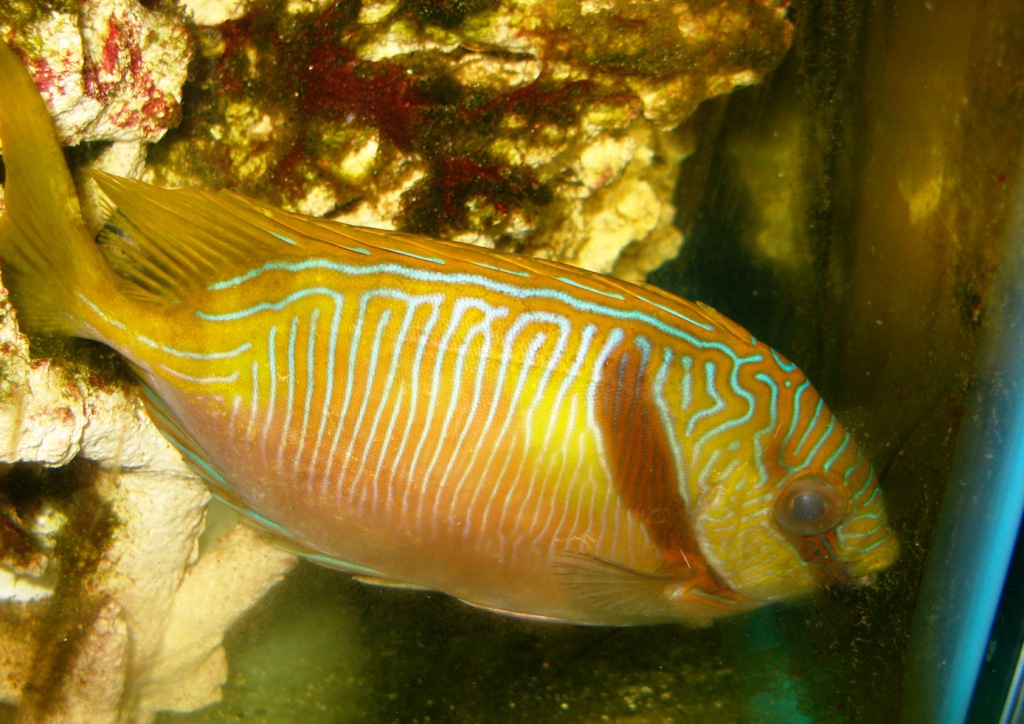
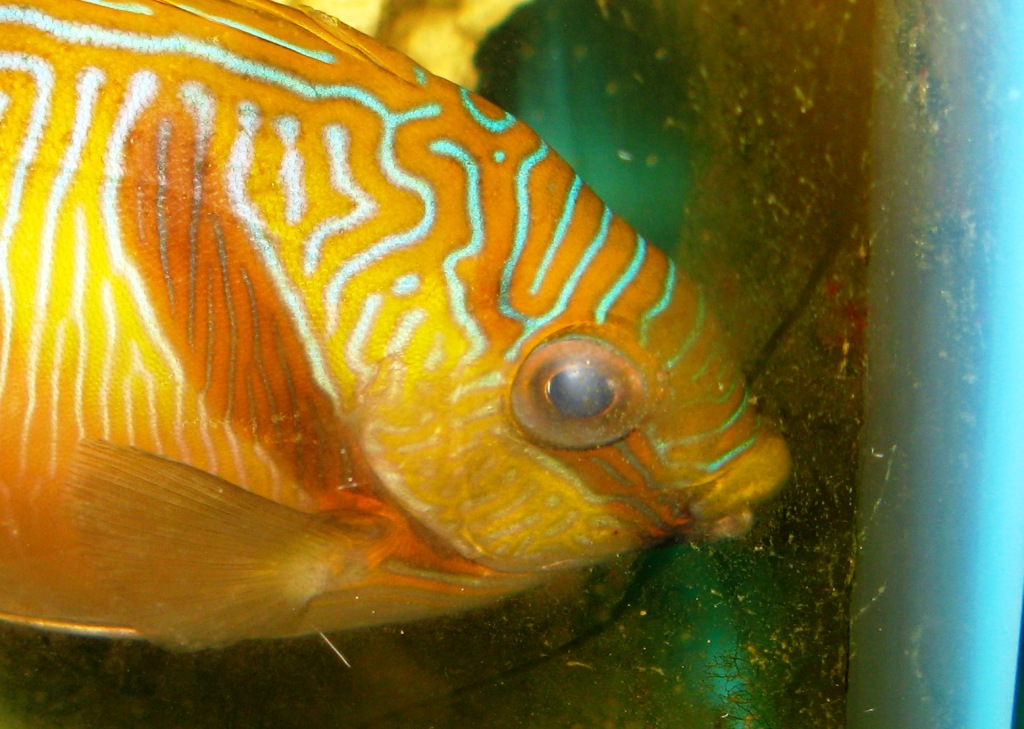
As the spots near the eye and near the top of the dark stripe appear minimal or gone, I presume you'd say these were the flukes, correct?
Kick ick dosent work i know because i lost alot of fish trying to make it work.
Wonder how they can sell it with a straight face.
On your algae try putting some mollies in there they are great should strip
any algae away then pass them on.
I had to lose a few tank full of fish to ick before i bit the bullet for a 40breeder quarantine.
I've had mixed results with Kick Ich, when I've used it in the past it's been about 50/50. Unfortunately, this case is on the wrong side of that balance.
I actually had some mollies in the tank awhile back, but they wouldn't eat the algae and kept going through the overflow (until I blocked it off) and I eventually had to remove them.
As for the QT, I understand, but that's not the issue here, as I had both of these fish for some time (the rabbitfish, actually a good bit longer) with no issues. Unless you are suggesting the 40 breeder for a hospital tank as well, which would be great -- except I'd have to put it on the dining room table because there is nowhere else for it. And as much as I like my fish, if it's them or me (vis-a-vis my wife, and her reaction to "losing" the dining room table) I'm going to pick me.

I've got the message not to mix cupramine & prazi; does anyone know offhand if our N. VA sponsoring LFSs carry Coppersafe and the pure prazi? Has anyone had luck using a post-Coppersafe setup with any inverts? Thanks again everyone!
-
No, but this isn't my main display tank. At the same time, the real reason for the tank is a 30" snowflake moray, which (fortunately) so far shows no signs of any malady whatsoever; I have nowhere else to put him, so need to treat in situ. Can I use the cupramine and prazi at the same time, or does it need to be sequential?
-
I've been battling what I believe to be an ich outbreak in my eel tank since Christmas. Nitrates a bit high (working on that), all other parameters good. So far I've treated with the following:
- Kick Ich (~3 weeks)
- generic methylene blue/formalin treatment (~10 days)
- SeaChem Paraguard (into third week now).
Just prior to/immediately after switching to the Paraguard I lost several fish (porcupine puffer, blue reef chromis, lawnmower blenny, Klein's butterfly), which I attribute at least partially to the generic treatment being ineffective. The snowflake moray has shown no sign, but the scribbled rabbitfish has been symptomatic throughout, and the humu trigger is now showing signs. I have dropped the salinity to about 1.02, and have been doing 20% water changes about every other day for the past couple of weeks. Photos are posted below.
Although the tank is a FOWLR, I have wanted to keep the option of adding some algae-eating inverts (especially since the rabbitfish doesn't seem to like what's growing in the tank) so I'm reluctant to use copper. At the same time, I don't want to lose any more fish, and I think my 10-gallon frag/QT tank is too small to treat the rabbitfish in.
SO - am I mis-diagnosing this and treating for the wrong ailment? Is there any other effective, non-copper-based treatment I can use that leaves open the option for inverts in the future? For the longer term, how much would a UV sterilizer be effective in preventing these types of disease outbreaks?Thanks!
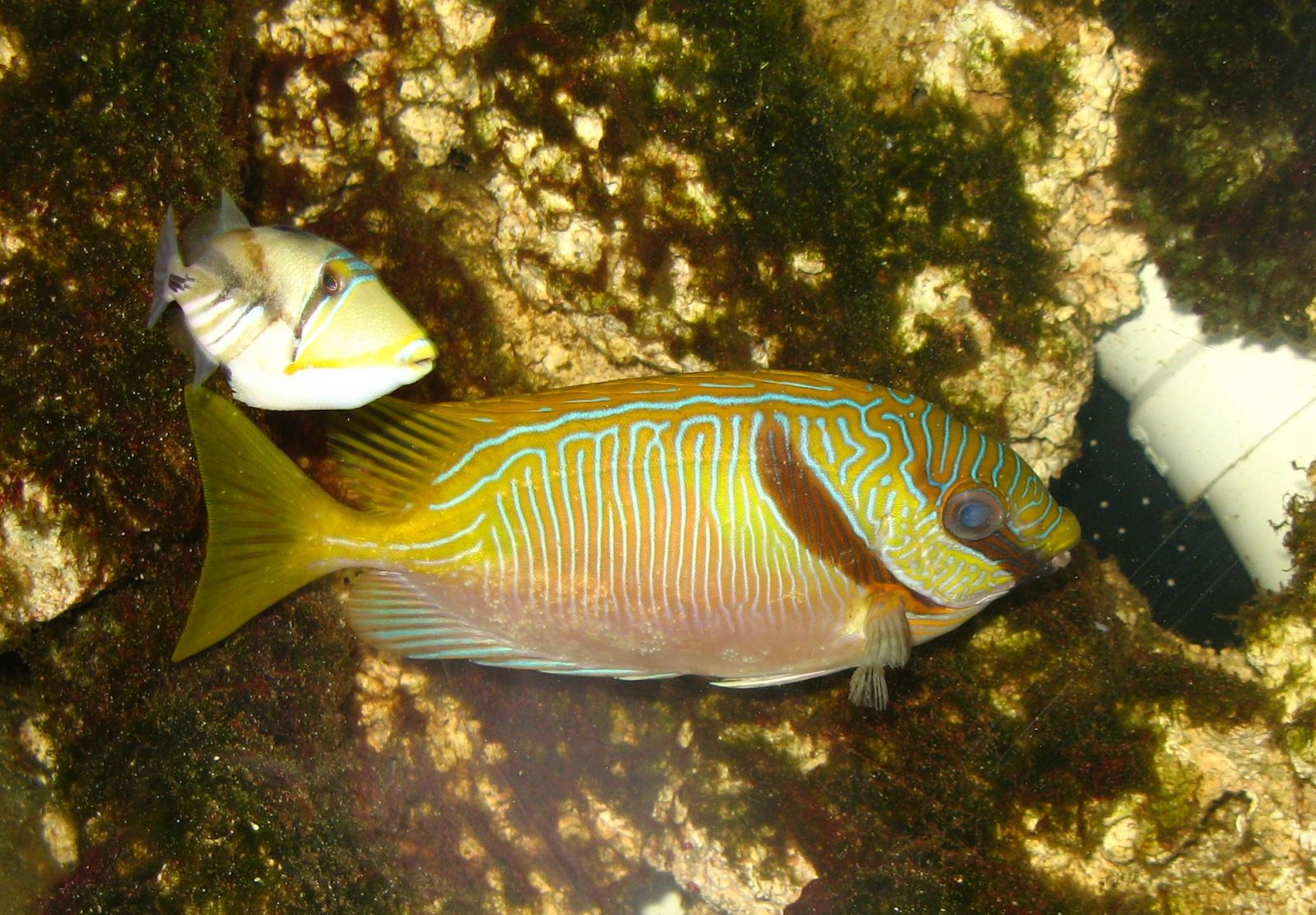
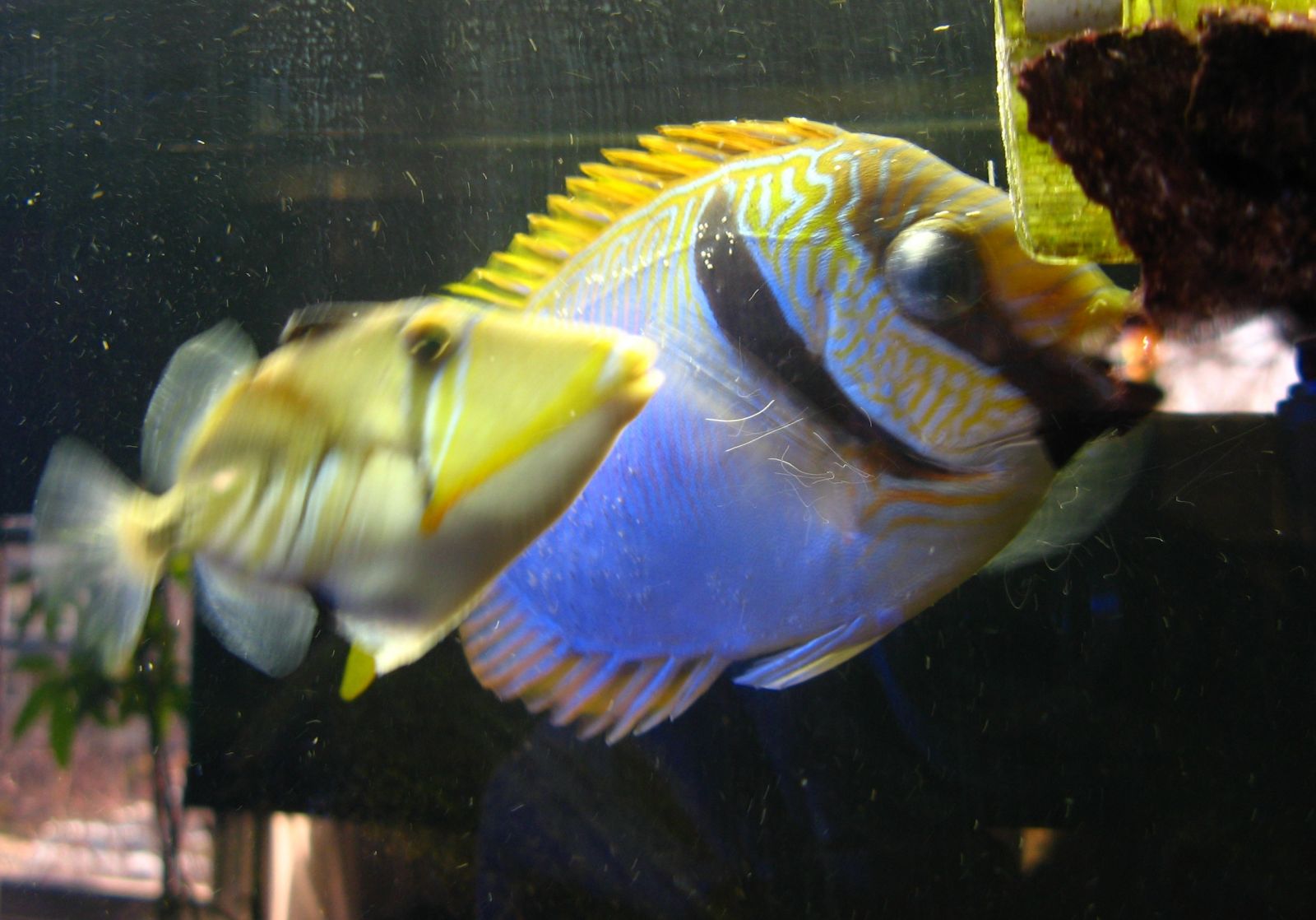
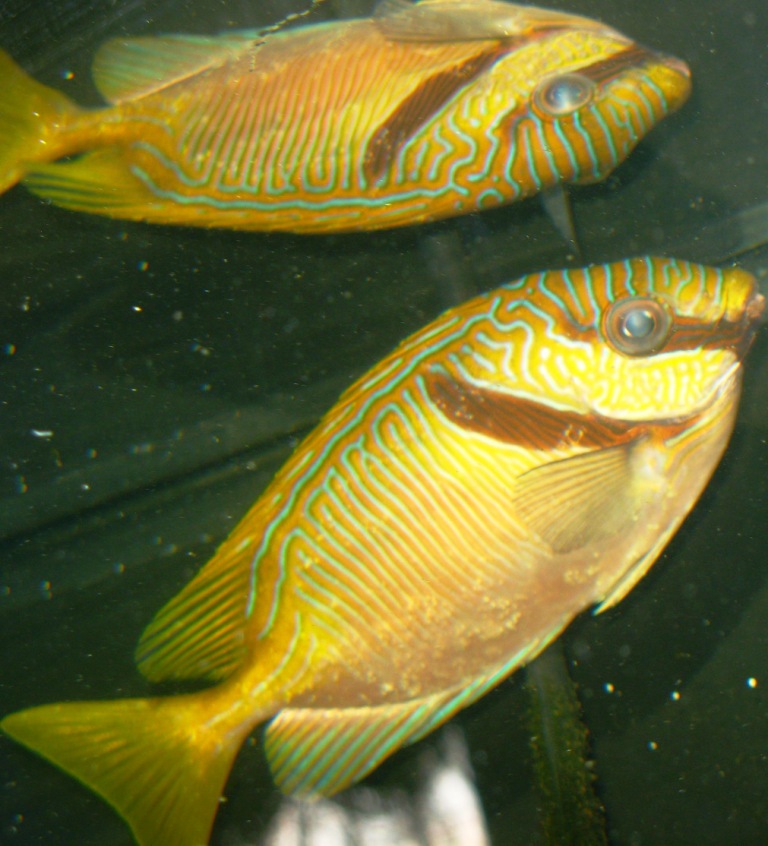
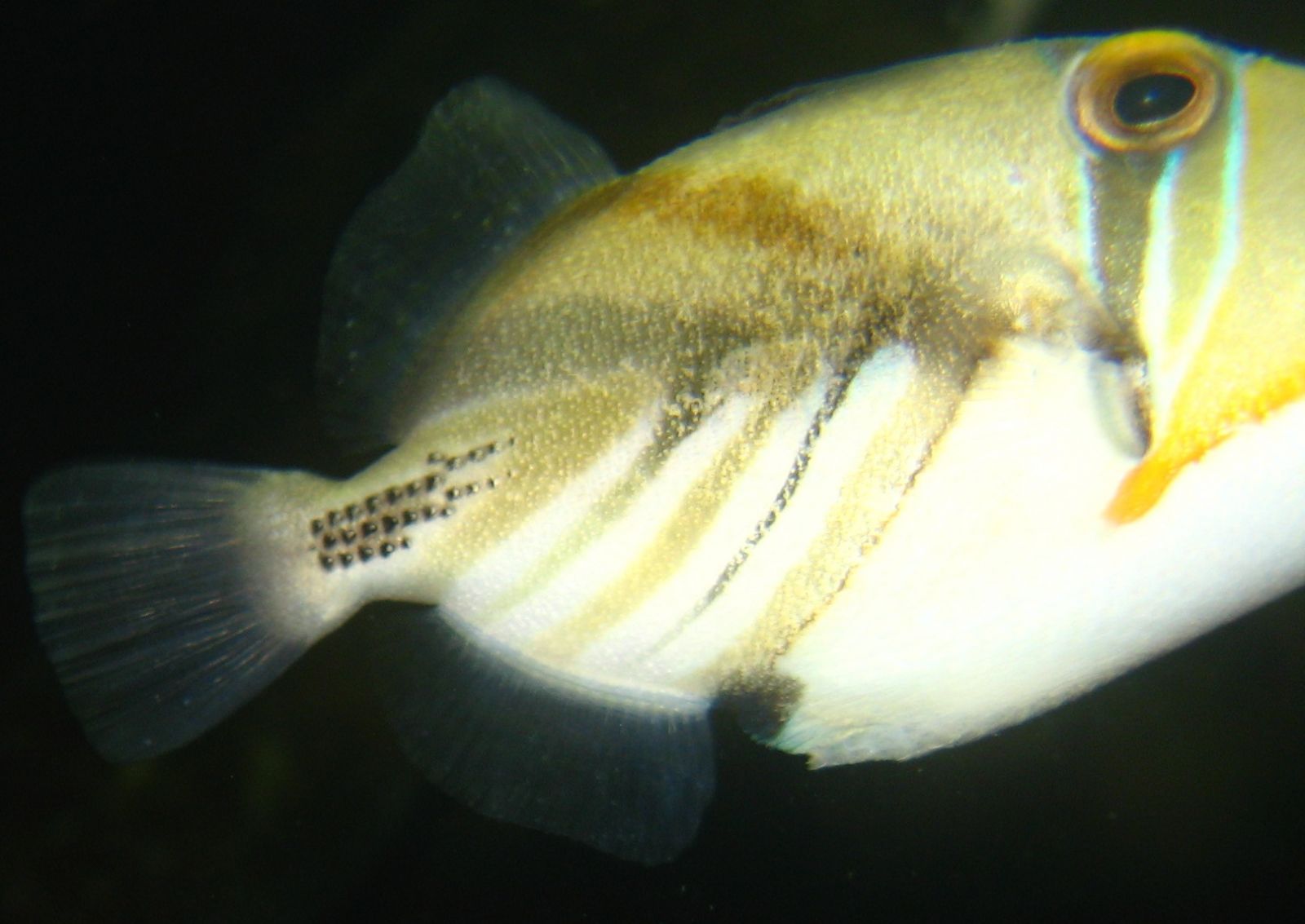
-
They look sort of like the stomatella (snails with only half a shell) that showed up in my tank, but I don't have a lot of confidence in that assessment. IF that's what they are, it's a good thing.
-
For more proof that dolphins are intelligent
 (probably no one on these boards), check out
(http://www.youtube.com/watch?v=2gvgkHSyKFE, in case the link doesn't work properly).
(probably no one on these boards), check out
(http://www.youtube.com/watch?v=2gvgkHSyKFE, in case the link doesn't work properly). -
Where can you get empty shells? I also try to get the LFS to toss in afew but it would be nice to just order a handfull.
Reefcleaners has small ones for $.07 and medium/large ones for twice that; Reefs2go is more, but they have a mixed lot of 100 for $25. If you've got larger hermits, Michael's (the craft store) periodically has bags of mixed empty shells (not all of which are crab-suitable) for decorating at about $8 a bag, if I'm remembering correctly, although I boil those to make sure they're clean before they go in the tank. I think most LFS have at least some as well.
-
So, to clarify, between 6 and 7 in Centerville? I may be able to help but can't commit yet; please PM address and I'll let you know as soon as I do.
-
A computer battery backup certainly ought to work. As to how long it would last, you should be able to calculate that from the backup capacity and the rated output on the heater (i.e., a 750 watt/hour backup with a 150W heater should run for five hours). Assuming the heater doesn't have to run constantly, the effective time should be longer, although there are probably too many variables to tell how much longer.




natural sea water question
in General Discussion
You are correct, and you can rent any and all gear you need at MWR as well.